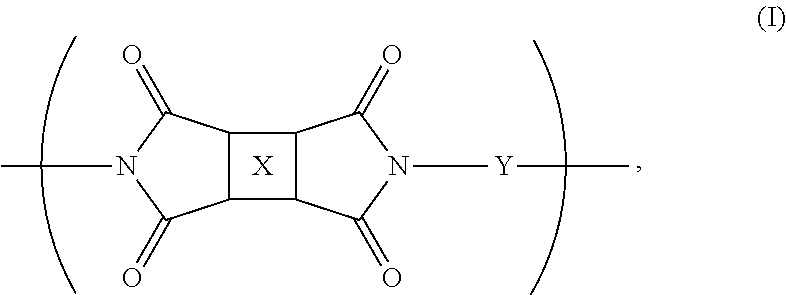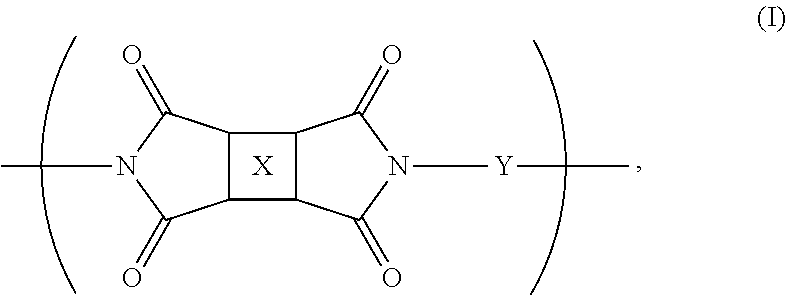Fluorinated polyimides with fluorene cardo structure as optical materials that have low absolute thermo-optic coefficients
a fluorene cardo structure and fluorinated polyimide technology, applied in the field of polyimide materials, can solve the problems of reducing the optical clarity of the composite, reducing the refractive index, and poor processability
- Summary
- Abstract
- Description
- Claims
- Application Information
AI Technical Summary
Benefits of technology
Problems solved by technology
Method used
Image
Examples
example 1
Polyimide Formulation 1
[0034]In this Example a polyimide composition was prepared by dissolving 2.89 grams (0.0065 mol) of 2,2-bis(3,4-dicarboxyphenyl)hexafluoropropane dianhydride (Chriskev Company, Inc., Lenexa, Kans.) and 2.28 grams (0.0060 mol) of 9,9-bis(4-amino-3-methylphenyl)fluorene (TCI America, Portland, Oreg.) in N,N′-dimethyl acetamide (Sigma-Aldrich, St. Louis, Mo.) to a final concentration of 15% by weight solids, followed by stirring at 60° C. under inert atmosphere for 24 hours. Next, toluene was added to the resulting amic acid solution to form an azeotropic solution and remove water during imidization. Imidization was then carried out by heating the solution to 150° C. for an additional 12 hours. The resulting imide solution was spin coated onto a silicon wafer at 1,500 rpm for 60 seconds, followed by baking at 205° C. for 180 seconds to form a void-free homogeneous film.
example 2
Polyimide Formulation 2
[0035]In this Example, a further polyimide composition was prepared by dissolving 2.58 grams (0.0040 mol) of 2,2-bis(3,4-dicarboxyphenyl)hexafluoropropane dianhydride (Chiskev Company, Inc.) and 3.00 grams (0.0056 mol) of 9,9-bis(4-(4-aminophenoxyphenyl))fluorene (JFE Chemical Corporation, Tokyo, Japan) in N,N′-dimethyl acetamide to a final concentration of 18% by weight solids, followed by stirring at 60° C. under inert atmosphere for 24 hours. Next, toluene was added to the resulting amic acid solution to form an azeotropic solution, and remove water during imidization. Imidization was then carried out by heating the solution to 150° C. for an additional 12 hours. The resulting imide solution was spin coated onto a silicon wafer at 1,500 rpm for 60 seconds, followed by baking at 205° C. for 180 seconds to form a void-free homogeneous film.
example 3
Polyimide Formulation 3
[0036]In this Example, another polyimide composition was prepared by dissolving 2.59 grams (0.004 mol) of 99-bis (4-(3,4-dicarboxyphenoxy)phenyl)fluorene dianhydride and 2.06 grams (0.004 mol) of 2,2-bis[4-(4-aminophenoxy phenyl)]hexafluoropropane (Chriskev Company, Inc.) in N,N-dimethyl acetamide to a final concentration of 14% by weight solids, followed by stirring at 60° C. under inert atmosphere for 24 hours. Next, toluene was added to the resulting amic acid solution to form an azeotropic solution and remove water during imidization. Imidization was then carried out by heating the solution to 150° C. for an additional 12 hours. The resulting imide solution was spin coated onto a silicon wafer at 1,500 rpm for 60 seconds, followed by baking at 205° C. for 180 seconds to form a void-free homogeneous film.
PUM
| Property | Measurement | Unit |
|---|---|---|
| temperatures | aaaaa | aaaaa |
| temperatures | aaaaa | aaaaa |
| optical wavelength range | aaaaa | aaaaa |
Abstract
Description
Claims
Application Information
 Login to View More
Login to View More - R&D
- Intellectual Property
- Life Sciences
- Materials
- Tech Scout
- Unparalleled Data Quality
- Higher Quality Content
- 60% Fewer Hallucinations
Browse by: Latest US Patents, China's latest patents, Technical Efficacy Thesaurus, Application Domain, Technology Topic, Popular Technical Reports.
© 2025 PatSnap. All rights reserved.Legal|Privacy policy|Modern Slavery Act Transparency Statement|Sitemap|About US| Contact US: help@patsnap.com



